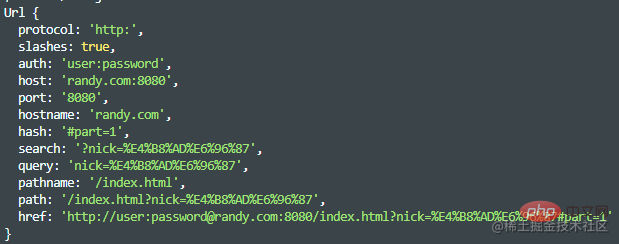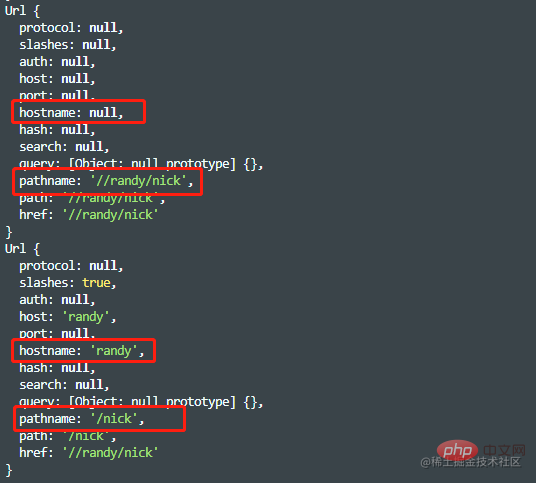
The

urlmodule and thequerystringmodule are two very importantURLprocessing modules. It is often used when doingnodeserver development.
Before introducing theurlmodule, let’s take a picture first. After understanding this picture, it is useful forurlYou will basically have no problems with this module.

Let’s explain their respective meanings
:, and is lowercase. [Related tutorial recommendations:nodejs video tutorial,Programming teaching]:is followed by two//, then it is true.usrname:passwd, if not, it isusrname. Note that this is case sensitive.ke.qq.com:8080, and is in lowercase.?, in addition, the value is not decoded.searchwith?removed, and the rest is the same; if it is an object, it is decoded.protocolandhostwill be converted into lowercase letters.Let’s explain its three common methods
This method willurlstring is parsed intoobject, which is convenient for developers to operate.
const url = require("url"); const str = "http://user:password@randy.com:8080/index.html?nick=%E4%B8%AD%E6%96%87#part=1"; const obj = url.parse(str); console.log(obj);
Output

parseQueryStringandslashesDenoteHos
parseQueryString: (default is false) If it isfalse, thenurlObject.queryis an unparsed string, such asnick= Chinese, and the corresponding value will notdecode; ifparseQueryStringis true, thenurlObject.queryisobject, for example{ nick: 'Chinese' }, and the value will be `decoded;
const url = require("url"); const str = "http://user:password@randy.com:8080/index.html?nick=%E4%B8%AD%E6%96%87#part=1"; const obj2 = url.parse(str, true); console.log(obj2);

slashesDenoteHos: (default is false) If it istrue, thenrandyin//randy/nickwill be consideredhostname; if it isfalse, thenrandyis considered to be part ofpathname.
const str2 = "//randy/nick"; const obj3 = url.parse(str2, true, false); console.log(obj3); const obj4 = url.parse(str2, true, true); console.log(obj4);

parse. Convert the object into aurlstring.
const pathObj = { protocol: "http:", slashes: true, auth: "user:password", host: "randy.com:8080", port: "8080", hostname: "randy.com", hash: "#part=1", search: "?nick=%E4%B8%AD%E6%96%87", query: "nick=%E4%B8%AD%E6%96%87", pathname: "/index.html", path: "/index.html?nick=%E4%B8%AD%E6%96%87", href: "http://user:password@randy.com:8080/index.html?nick=%E4%B8%AD%E6%96%87#part=1", }; console.log(url.format(pathObj)); // http://user:password@randy.com:8080/index.html?nick=%E4%B8%AD%E6%96%87#part=1
URLrelative to the baseURL.
console.log(url.resolve("/one/two/three", "four")); // /one/two/four console.log(url.resolve("http://example.com/", "/one")); // http://example.com/one console.log(url.resolve("http://example.com/one", "/two")); // http://example.com/two console.log(url.resolve("http://example.com/one/ddd/ddd/ddd", "./two")); // http://example.com/one/ddd/ddd/two console.log(url.resolve("http://example.com/one/ddd/ddd/ddd", "../two")); // http://example.com/one/ddd/two console.log(url.resolve("http://example.com/one/ddd/ddd/ddd", ".../two")); // http://example.com/one/ddd/ddd/.../two
querystringThis module is also used to parseurlquery parameters. Here we focus on analyzing its two methodsparseandstringify.
parseis to convert the query string into an object type, and alsodecode.
const querystring = require("querystring"); const str = "nick=randy&age=24&nick2=%E4%B8%AD%E6%96%87"; const obj = querystring.parse(str); console.log(obj); // { nick: 'randy', age: '24', nick2: '中文' }
& and =with custom characters. The author will give an example below and you will understand quickly.
const str1 = "name-randy|country-cn"; const obj1 = querystring.parse(str1); console.log(obj1); // { 'name-randy|country-cn': '' } const obj2 = querystring.parse(str1, "|", "-"); console.log(obj2); // { name: 'randy', country: 'cn' }
&with|, and replacing=with-. The author feels that this situation should be rare.
parse. Let’s go directly to the example
const obj3 = { nick: "randy", age: "24", }; const str4 = querystring.stringify(obj3); console.log(str4); // nick=randy&age=24
const obj5 = { name: "randy", country: "cn", }; const str6 = querystring.stringify(obj5, "|", "-"); console.log(str6); // name-randy|country-c
更多node相关知识,请访问:nodejs 教程!
The above is the detailed content of Let's talk about the url module and querystring module in Node. For more information, please follow other related articles on the PHP Chinese website!
 Is python front-end or back-end?
Is python front-end or back-end? node.js debugging
node.js debugging How to implement instant messaging on the front end
How to implement instant messaging on the front end The difference between front-end and back-end
The difference between front-end and back-end Introduction to the relationship between php and front-end
Introduction to the relationship between php and front-end Server request timeout solution
Server request timeout solution What to do if notepad.exe is not responding
What to do if notepad.exe is not responding Advantages of plc control system
Advantages of plc control system